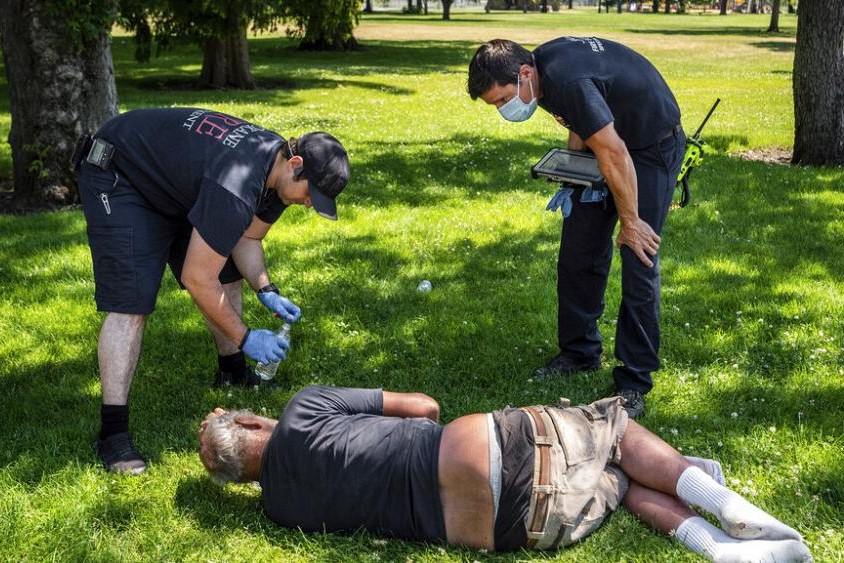
Assessment of abdominal trauma: inspection, auscultation and palpation of the patient
Abdominal trauma: the abdomen may be affected by several types of trauma; injuries may be limited to the abdomen alone or be accompanied by severe multisystem trauma
The nature and severity of abdominal injuries vary widely depending on the mechanism and forces involved, so generalisations about mortality and the need for repair tend to be misleading.
Injuries are often classified according to the type of structure damaged:
- Abdominal wall
- Solid organ (liver, spleen, pancreas, kidneys)
- Hollow viscera (stomach, small intestine, colon, ureters, bladder)
- Vascular system
Some specific injuries caused by abdominal trauma are discussed elsewhere, including those of the liver, spleen and genitourinary tract.
Assessment of abdominal trauma focuses on
The abdominal assessment is focused on
- inspection (including DCAP-BTLS),
- auscultation, and
- palpation.
What follows is a brief description of common signs that these exam maneuvers will uncover and what they mean in the setting of the abdominal trauma patient.
RESCUERS’ RADIO IN THE WORLD? VISIT THE RADIO EMS BOOTH AT EMERGENCY EXPO
Inspection
Assessing for abdominal distention and the presence of bruise patterns are the highest yield elements of inspection.
ABDOMINAL DISTENTION: Abdominal shape or “distention” is asymmetrical or there is asymmetrical abdominal enlargement. This is a sign of internal bleeding.
BRUISE PATTERNS: can mean many things, the most common being:
CULLEN’S SIGN: periumbilical bruising that can be present with internal hemorrhage.
GREY TURNER’S SIGN: bruising on the side above the hip and below the ribs that may indicate retroperitoneal hemorrhage.
The mnemonic for remembering how to distinguish between these signs:
Grey-TURNer’s sign is located when you TURN towards your flank and
CUllen’s sign is located around the Umbilicus.
SEATBELT SIGN: patterns across the abdomen in the shape of a seatbelt are another sign that there may be internal damage or bleeding. These are associated with liver rupture and diaphragm injury.
DCAP-BTLS
The acronym DCAP-BTLS is an essential component of inspection when performing a secondary trauma survey. It refers to the major forms of injury that should be sought out in trauma:
Deformities/Discolorations
Crepitus/Contusions
Abrasion/Avulsion
Penetrations/Punctures
Burns
Tenderness
Lacerations
Swelling/Symmetry.
Auscultation
The utility of auscultation in the acute trauma setting is limited.
Environmental noise and the rarity of signs lead to other methods of assessment being preferred by most ambulatory providers. However, there are some specific signs that are high-yield for emergency room based providers and registry exams.
ABDOMINAL auscultation: This can help reveal damage to the major arteries in the abdomen:
the renal, iliac, and aortic arteries can create a “bruit” or abnormal fluid flow sound when injured. This can assist you in rapid identification of patients at risk of massive hemorrhage.
LUNG auscultation: While not a component of the abdomen,
the lung sounds can be reduced or replaced by the sounds of the intestines in cases where the left side of the diaphragm is ruptured. Hearing abdominal sounds in the lung fields is the most reliable way to identify this injury.
Palpation
While often secondary to careful inspection, palpation of the abdomen is the best way to assess for injury to the deep structures within the abdomen.
The spleen and liver are vulnerable to trauma and can be easily palpated on the left and right sides of the abdomen, respectively, to assist in identifying sources of pain and/or bleeding. (You can correlate findings with left or right shoulder blade referred pain, respectively.)
The following is a stepwise breakdown of abdominal palpation.
Press lightly in each of the four abdominal quadrants to look for extremely sensitive areas.
Press deeply in each quadrant that is NOT extremely sensitive to light palpation. Pursue the normal areas first, to prevent causing further injury or pain, which could limit any further palpation.
Have your patient inhale fully, press your hand under the right ribs, keeping your fingertips in line with the nipples; then ask your patient to exhale. This allows you to palpate the edge of the liver. You may or may not feel the liver, but it should not be painful either way. (A palpable liver is usually an enlarged liver, e.g., hematoma, laceration, liver capsule swelling with blood, etc.) (Correlate with any referred pain to the right shoulder blade.)
Perform the above maneuver on the left side to palpate the spleen. A normal spleen should not be identifiable through palpation, nor should it be painful. (Correlate with any referred pain to the left shoulder blade.)
These maneuvers are extremely sensitive for intra-abdominal trauma and should be performed on any patient who is suspected of having a significant injury to an abdominal organ.
Read Also:
Emergency Live Even More…Live: Download The New Free App Of Your Newspaper For IOS And Android
What’s Causing Your Abdominal Pain And How To Treat It
Intestinal Infections: How Is Dientamoeba Fragilis Infection Contracted?
Early Parenteral Nutrition Support Cuts Infections After Major Abdominal Surgery
Acute Abdomen: Meaning, History, Diagnosis And Treatment


